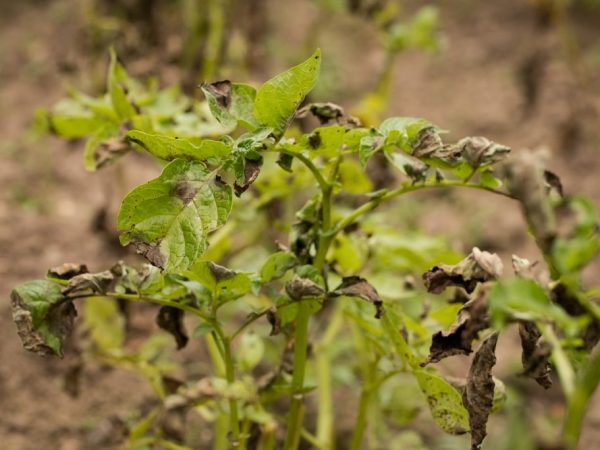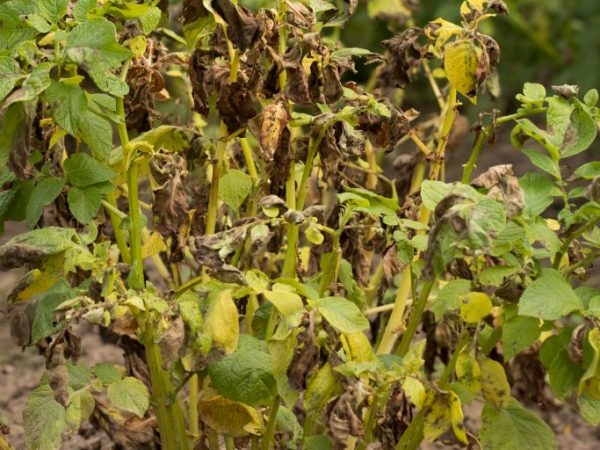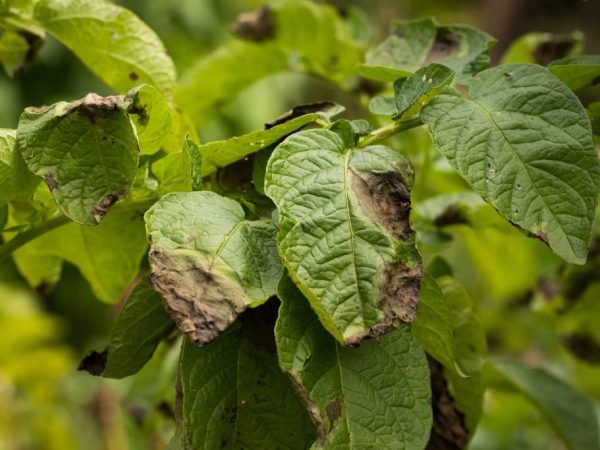Diseases of potato tops and methods of dealing with them
Diseases of potato tops have a negative impact on crop yields. Therefore, it is necessary to start treatment at the first symptoms of a disease. And for the treatment to be effective, you need to be able to recognize the disease. Consider what diseases of potato tops and leaves are found in our region, and how to deal with them.
- Striped or striped mosaic
- Symptoms
- Treatment and prevention
- Wrinkled mosaic
- Symptoms
- Treatment and prevention
- Ordinary mosaic
- Symptoms
- Treatment and prevention
- Aucuba Mosaic
- Symptoms
- Treatment and prevention
- Rolling the leaves
- Symptoms
- Treatment and prevention
- Post wilt
- Symptoms of the South Stlbur
- Symptoms of the northern stlbur
- Treatment and prevention
- Golden nematode
- Symptoms
- Treatment and prevention
- Late blight
- Symptoms
- Treatment and prevention

Diseases of potato tops
Striped or striped mosaic
This disease is caused by the Y virus. We will not go into the etymology of the disease, but only consider the description of its symptoms and existing methods of treatment.
Symptoms
First, the middle and lower leaves of the plant are affected. Light spots appear on them, and the color of the leaves becomes like a mosaic. Then, small dark necrotic spots, dots and stripes appear. As a rule, stripes are located on the inside of the leaf along the veins. At first, threadlike stripes appear along the short veins. After some time, the entire surface of the leaf is affected. Also, necrotic spots and stripes spread to the stem of the plant and its branches. But such damage indicates an advanced form of the disease. As the disease spreads, the leaves become brittle and darken, the petioles dry out. If the affected plant is left untreated, it dries up and eventually dies. As a rule, the death of plants occurs even before their flowering.
The source of infection is the seed infected with this virus. The virus is spread by pests that wander from one bush to another. When preparing seed, discard any tubers that have brown spots or necrotic rings. If, after cutting the seed material, it is painful to place healthy potatoes in one container, then the striped mosaic will spread to healthy tubers.
Treatment and prevention
Unfortunately, there are no drugs that could destroy the virus that provokes the striped mosaic. The only measure to combat this disease is the mechanical removal of all affected bushes.
As for the prevention of striped mosaic, it involves a careful selection of planting material.
Wrinkled mosaic
Wrinkled mosaic is another viral disease. It is caused by four viruses simultaneously: X, S, A, M.
Symptoms
The first symptoms appear on the leaves of the plant. The smooth part of the leaf, which is located between the veins, is deformed, and the edges of the leaves are bent inward. Leaves die off gradually. But they do not fall off, but remain hanging on the bush. Sometimes the stems begin to lay down.Although, the reason for the reclining of the stems may be the presence of pests.
The reason that the stems lie down is a malfunction of the stomatal apparatus, which is responsible for retaining moisture in the cells of the plant. Accordingly, the growing season in affected plants ends 25-30 days ahead of schedule. And this leads to loss of crops.

The problem starts with the tubers
The causative agents of this disease persist in the tubers of the plant. The virus is spread by pests wandering through the bushes. The disease also spreads mechanically (when a sick plant comes into contact with a healthy plant). Wrinkled mosaics affect some weeds, tomatoes and clover. Therefore, you need to monitor the condition of all plants growing on the site.
When a wrinkled mosaic of potatoes is affected in the first year, the disease proceeds with practically no symptoms. And on the bushes grown from the affected planting material, the symptoms are more pronounced. In addition to leaf deformation, there is a slowdown in the growth of bushes, fragility of leaves and stems.
Treatment and prevention
As with striped mosaic, the treatment of wrinkled mosaic is reduced to removing the affected bushes from the suburban area.
As for prevention, in addition to using high-quality planting material, it is worth decontaminating the soil before planting.
Ordinary mosaic
This potato disease is sometimes called speckled mosaic. Its causative agent is the X virus.
Symptoms
The description of the symptoms of a common mosaic is similar to the description of the symptoms of a wrinkled mosaic. Small specks of yellow-green color appear on the leaves of the plant. Over time, the affected tissue dies off, along with the top of the leaf, but the bush does not dry out. Deformations of the sheet may also appear. This disease does not lead to the death of the plant. Sometimes, the symptoms disappear after a while. But, it should be understood that no disease goes away without consequences. During the formation and maturation of tubers, changes took place in the structure of the plant, which could not but affect the quality of the crop. It is impossible to use such tubers as planting material. The disease in the second and third generations manifests itself more clearly and lowers the yield by 30-50%.
The virus is transmitted through the affected tubers, spread by rodents and pests. Healthy plants are affected by contact with diseased plants.
Treatment and prevention
Treatment of an ordinary mosaic is reduced to the removal of diseased plants from the site. And tomatoes, tobacco, clover, and some weeds are affected by this disease.
Preventive measures include the control of pests that spread viral infections.
Aucuba Mosaic

The virus infects the tops and potatoes
This is another viral disease that lowers potato yields.
Symptoms
Basically, the lower leaves of the plant are affected, on which light spots appear. Only a few varieties are an exception, and during the illness all leaves are covered with spots. In addition to the foliage, the tops and petioles are affected, on which necrotic spots can be found. As a rule, after the appearance of necrotic spots on the tops, the lower leaves of the plant die off. Sometimes, in addition to spotting, the leaf blade becomes wrinkled.
During storage, brown spots form inside the tubers. Such tubers cannot be used as planting material. They are also not recommended for consumption.
Treatment and prevention
Treatment of this type of mosaic involves the destruction of diseased plants. Even if the lesions are minor, and only a small part of the leaves have dried, the plants must be removed. They become a source of infection for healthy bushes. Phyto-cleaning should be started immediately after germination. We dig up all suspicious plants and remove them from the summer cottage. It is best to burn the diseased bush.
The carrier of this infection is aphid.Therefore, you need to take all measures to prevent the appearance of this pest in the summer cottage.
Rolling the leaves

Leaves are amazed
This viral disease, caused by the M virus, affects leaves, tops and tubers.
Symptoms
Symptoms are most pronounced on young leaves, which begin to curl upward. Light spots also appear on the leaves. Old leaves are rarely affected. It is possible to distinguish this disease from the above types of mosaics by the absence of fragility of tops and leaves.
Sometimes the edges of the leaves become wavy. Reddish spots appear on the leafy part of some potato varieties. Also, the tops sometimes curl. And in some cases, the disease is asymptomatic.
All symptoms appear only in the first half of the growing season, after which they are masked.
Treatment and prevention
Treatment involves the destruction of diseased bushes.
Prevention includes pest control and the use of quality planting material.
Post wilt
Pillar wilt is caused by phytoplasmic organisms. There are two forms of this disease:
- southern slalbur;
- northern slolbur.
Symptoms of the South Stlbur
This form of the disease is common in the south of the country. A light border appears on the upper leaves, the distance of internodes decreases, axillary leaves grow poorly. The stems become brittle. The disease quickly infects the plant. Already on the 10th day, the potatoes wither, and after 3-4 weeks the plant dries up.
Symptoms also appear on inflorescences that are deformed. Often, the leaves grow together. Stamens and pistils develop poorly. Some flowers remain green or colorless. Typically, these flowers are not pollinated.
Symptoms of the northern stlbur
The northern pillar manifests itself in a slightly different way. It is most often found in the northern region, although there are exceptions. The affected potato grows slowly, excessive branching is observed, and the formed leaves are small in size. Most of the inflorescences at the northern column are colored green. The plant does not dry out. This is the main difference between the northern form and the southern one.
Treatment and prevention
There is no cure for this disease. The fight against stovbur involves the destruction of affected plants by burning at the stake.
Most often, Stovbur affects weeds, especially birch trees. Therefore, in order to prevent from the summer cottage, we remove all types of weeds. You also need to carefully choose the planting material. Tubers affected by stovbur give filamentous shoots.
It is strictly forbidden to eat tubers affected by this disease.
Golden nematode

Bad leaves and slow growth
This disease, also called globoderosis, is caused by worms that live in the root system of the plant.
Symptoms
Affected potatoes grow slowly. At the time of the end of growth, diseased bushes are 1.5-2 times lower than healthy ones. Often, during the growth process, the lower leaves of the potato fall off. In general, the plant looks lethargic. During flowering, inflorescences are few, or they are completely absent. Some plants die before harvesting. Bushes affected by a nematode become vulnerable to fungal diseases.
Treatment and prevention
There are no chemical preparations to combat this pest. Therefore, as is the case with various types of mosaics, the affected plants are simply removed from the site and burned at the stake.
As for preventive measures, experts recommend constantly changing the planting site of this vegetable crop. Golden nematode remains in the soil and infects healthy planting material. Even after harvesting, the soil should be disinfected. After potatoes, the territory should be planted with cereals and grain crops. The soil should rest after potatoes for at least 3 years.
Late blight
The description of this disease is known to every farmer, since it is one of the most common in our region. Late blight affects both the aerial part of the plant and the potato tubers. Yield losses during late blight are 65-70%.
Symptoms
The lower leaves of the plant are affected first. First, wet spots appear on them, resembling dew. Then, brown spots appear in place of the wet ones. In parallel with the formation of brown spots, a white bloom appears on the back of the leaf plate. It indicates that the fungus, which is the cause of late blight, spreads spores. Over time, the tops of the plant are affected, after which it is almost impossible to save the bush. The plant gradually loses its leaves and dries up.
The disease develops at high humidity, so you need to plant potatoes wide enough.
Treatment and prevention
When plants are damaged, it is useless to use chemical preparations. All diseased leaves must be removed. If the lesion has spread to the stem, then it is advisable to remove the entire bush. But, if a small part of the stem at the top of the bush is affected, then you can pinch it off. We carefully observe the affected bushes for the presence of new lesions.
As a preventive measure, we periodically process the vegetable crop with fungicides, which are sold in specialized stores. We stop processing after the tops dry up and fall. It is advisable to process these means and planting material. It is also very important to carry out the harvest in a timely manner. With late harvest, the likelihood of infection of the tubers with this disease is high.


